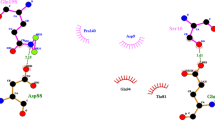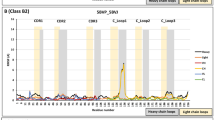Abstract
Antibody drugs are very useful tools for the treatment of many chronic diseases. Recently, however, patients and doctors have encountered the problem of drug resistance. How to improve the affinity of antibody drugs has therefore become a pressing issue. Ibalizumab is a humanized monoclonal antibody that binds human CD4, the primary receptor for human immunodeficiency virus type 1. This study investigates the mutation residues of the complementarity determining regions of Ibalizumab. We propose using the wild and mutations of Ibalizumab–human CD4 receptor complex structures, molecular dynamics techniques, alanine-scanning mutagenesis calculations and solvated interaction energies methods to predict the binding free energy of the Ibalizumab–human CD4 receptor complex structures. This work found that revealed three key positions (31th, 32th and 33th in HCDR-1) of the residues may play an important role in Ibalizumab–human CD4 receptor complex interactions. Therefore, bioengineering substitutions of the three key positions and increasing number of intermolecular interactions (HCDR-1 of Ibalizumab/human CD4 receptor) might improve the binding affinities of this complex structure.






Similar content being viewed by others
References
Frederick B, Charles B (1922) J Lab Clin Med 7:251
Fallacara AL, Tintori C, Radi M, Schenone S, Botta M (2014) J Chem Inf Model 54(5):1325
Leader B, Baca QJ, Golan DE (2008) Nat Rev Drug Discov 7(1):21
Palella FJ, Delaney KM, Moorman AC, Loveless MO, Fuhrer J, Satten GA, Aschman DJ, Holmberg SD (1998) N Engl J Med 338(13):853
Rivera A, Ro G, Van Epps HL, Simpson T, Leiner I, Sant’Angelo DB, Pamer EG (2006) Immunity 25(4):665
Xu H, Littman DR (1993) Cell 74(4):633
Doyle C, Strominger JL (1987) Nature 330(6145):256
Lu M, Blacklow SC, Kim PS (1995) Nat Struct Mol Biol 2(12):1075
Modrow S, Hahn BH, Shaw GM, Gallo RC, Wong-Staal F, Wolf H (1987) J Virol 61(2):570
Leonard CK, Spellman MW, Riddle L, Harris RJ, Thomas JN, Gregory TJ (1990) J Biol Chem 265(18):10373
Cohen J (1996) Science 272(5263):809
Overbaugh J, Morris L (2012) Cold Spring Harb Perspect Med 2(1):a007039
Mikell I, Sather DN, Kalams SA, Altfeld M, Alter G, Stamatatos L (2011) PLoS Pathog 7(1):e1001251
Huang J, Ofek G, Laub L, Louder MK, Doria-Rose NA, Longo NS, Imamichi H, Bailer RT, Chakrabarti B, Sharma SK, Alam SM, Wang T, Yang Y, Zhang B, Migueles SA, Wyatt R, Haynes BF, Kwong PD, Mascola JR, Connors M (2012) Nature 491(7424):406
Gach JS, Achenbach CJ, Chromikova V, Berzins B, Lambert N, Landucci G, Forthal DN, Katlama C, Jung BH, Murphy RL (2014) PLoS ONE 9(1):e85371
Connors M, Huang J, Laub LB, Kwong P, Nabel G, Mascola JR, Zhang B, Rudicell RS, Georgiev I, Yang Y. Neutralizing gp41 antibodies and their use. Google Patents, 2013
Burkly L, Olson D, Shapiro R, Winkler G, Rosa J, Thomas D, Williams C, Chisholm P (1992) J Immunol 149(5):1779
Bruno CJ, Jacobson JM (2010) J Antimicrob Chemother 65(9):1839
Boon L, Holland B, Gordon W, Liu P, Shiau F, Shanahan W, Reimann KA, Fung M (2002) Toxicology 172(3):191
Freeman MM, Seaman MS, Rits-Volloch S, Hong X, Kao C-Y, Ho DD, Chen B (2010) Structure 18(12):1632
Toma J, Weinheimer SP, Stawiski E, Whitcomb JM, Lewis ST, Petropoulos CJ, Huang W (2011) J Virol 85(8):3872
Dolinsky TJ, Czodrowski P, Li H, Nielsen JE, Jensen JH, Klebe G, Baker NA (2007) Nucleic Acids Res 35(Suppl 2):W522
Yang XQ, Liu JY, Li XC, Chen MH, Zhang YL (2014) J Chem Inf Model 54(5):1356
Allcorn LC, Martin ACR (2002) Bioinformatics 18(1):175
Salomon-Ferrer R, Case DA, Walker RC (2013) Wiley Interdiscip Rev Comput Mol Sci 3(2):198
Jorgensen WL, Chandrasekhar J, Madura JD, Impey RW, Klein ML (1983) J Chem Phys 79(2):926
Andersen HC (1980) J Chem Phys 72(4):2384
Ryckaert J-P, Ciccotti G, Berendsen HJC (1977) J Comput Phys 23(3):327
Darden T, York D, Pedersen L (1993) J Chem Phys 98(12):10089
Roe DR, Cheatham TE (2013) J Chem Theory Comput 9(7):3084
Diller DJ, Humblet C, Zhang X, Westerhoff LM (2010) Proteins Struct Funct Bioinform 78(10):2329
Perdih A, Bren U, Solmajer T (2009) J Mol Model 15(8):983
Bren U, Martínek V, Florián J (2006) J Phys Chem B 110(21):10557
Åqvist J, Medina C, Samuelsson J-E (1994) Protein Eng 7(3):385
Cui Q, Sulea T, Schrag JD, Munger C, Hung M-N, Naïm M, Cygler M, Purisima EO (2008) J Mol Biol 379(4):787
Purisima EO (1998) J Comput Chem 19(13):1494
Bhat S, Purisima EO (2006) Proteins Struct Funct Bioinform 62(1):244
Acknowledgments
The authors would like to thank the Kaohsiung Medical University of the Republic of China and the National Science Council of the Republic of China, Taiwan, for supporting this research (Contract No. NSC 101-2113-M-492-001-MY2, KMU-Q103012 and KMU-TP103C00).
Author information
Authors and Affiliations
Corresponding author
Electronic supplementary material
Below is the link to the electronic supplementary material.
Rights and permissions
About this article
Cite this article
Wang, YT., Chuang, LY. Insight into the modified Ibalizumab–human CD4 receptor interactions: using a computational binding free energy approach. J Comput Aided Mol Des 29, 69–78 (2015). https://doi.org/10.1007/s10822-014-9805-4
Received:
Accepted:
Published:
Issue Date:
DOI: https://doi.org/10.1007/s10822-014-9805-4




